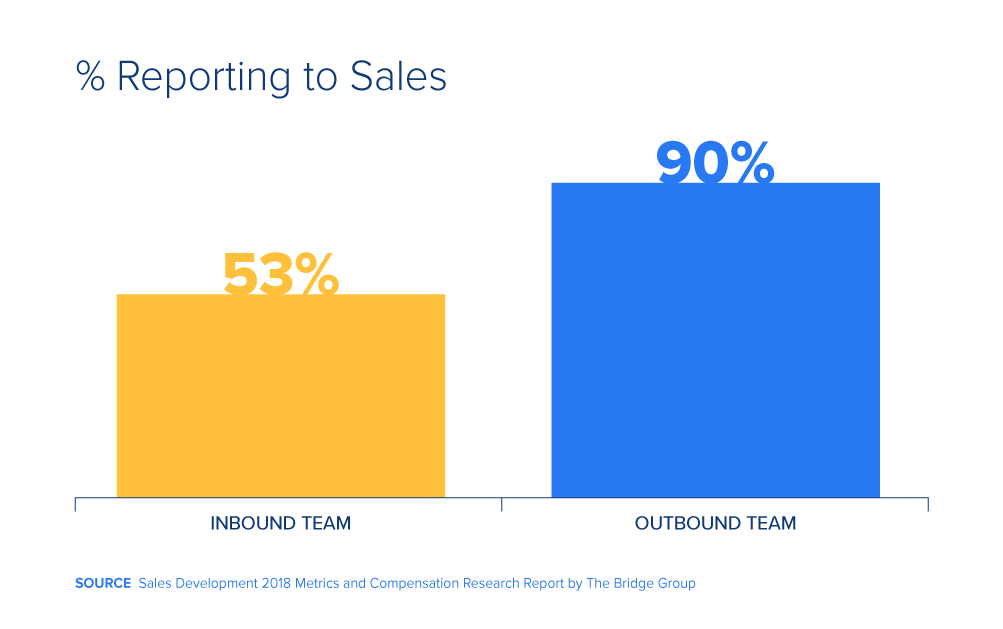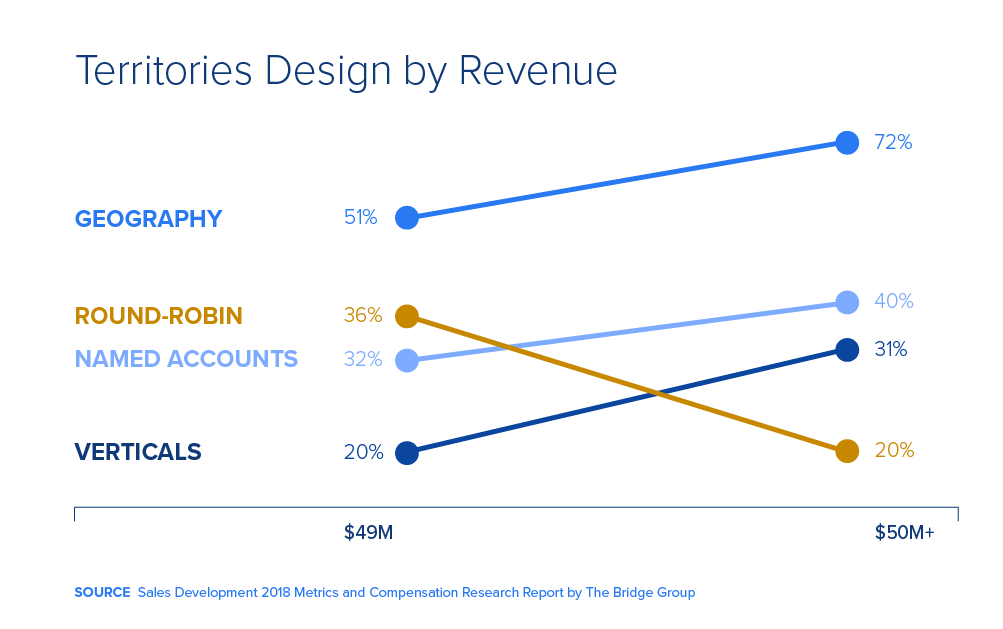Inbound SDR vs. Outbound SDR: Why Your Sales Process Needs an All-bound Strategy


Brent Walrath
This post was originally published in July 2019 and has been updated for accuracy and comprehensiveness.
Today, many B2B companies silo their sales development team into inbound-only and outbound-only reps. However, this can lead to team misalignment and even brand misrepresentation.
We’ve found that — based on our 15+ years of managing the SDR team for both our company and clients — an all-bound strategy leads to better conversions and fosters stronger relationships with prospects. This strategy empowers organizations to set themselves up for long-term scalability with an enhanced ability to manage strategic accounts through precise team performance tracking.
In this post, we’ll discuss:
- What is an inbound SDR?
- What is an outbound SDR?
- How the siloed SDR approach is messy
- How to develop an all-bound sales development strategy
- Benefits of creating an all-bound SDR strategy
Let’s first distinguish between an inbound and outbound SDR.
What is an inbound SDR?
An inbound sales development rep follows up with warm leads, which have been generated through marketing initiatives. These leads are considered warm because they have prior knowledge or interest in your company before an SDR contacts them.
These marketing-qualified leads (MQLs) are funneled into the database through activities, such as:
- Submitting a contact form on your website to request a call
- Signing up for your newsletter list or subscribing to your blog
- Submitting a landing page form in exchange for a content download
- Giving you their information in person at a trade show or other networking events
Certain marketing activities suggest a higher level of interest than others. A hand-raising action, like requesting a call, implies more interest than downloading a general educational content piece. That’s why it’s important to understand your MQL lead sources and their impact on your pipeline.
Because inbound leads are generally easier to qualify and set sales meetings for, many companies get away with paying inbound SDRs less than outbound reps. The difference in compensation might explain why some companies feel compelled to silo their SDR teams.
What is an outbound SDR?
An outbound SDR initiates relationships by making the first contact with a lead through a cold call. These leads are called cold leads.
Cold leads are mostly found through data-building efforts, such as partnering with a contact database provider, to find leads who meet a specified buyer persona. Keep in mind that finding the right lead list is pertinent to your outbound outreach efforts — as inaccurate B2B sales data wastes more than 25% of a salesperson’s time.
If you’re struggling to find highly accurate leads, consider switching to EBQ’s Data Department. We can create highly targeted contacts — no matter what your industry is and who you’re targeting. Get in touch with our Consultants to learn how our data specialists can accelerate your sales efforts.
Because cold leads often have no prior knowledge of your company, it’s much more difficult for an SDR to generate interest in your product/offering.
We’ve found that the unsolicited nature of cold calling often results in much lower conversion rates for cold leads compared to warm leads. One study found that less than 2% of cold calls turn into set appointments.
Still, investing in an outbound sales development strategy is worth it — because converting even 2% of your cold leads can lead to closing on high-value deals. Outbound sales often drives inbound leads; it generates awareness of your product that is often shared with other relevant prospects outside of your funnel. We’ll lay out this process later in the blog post.
At this point, it’s clear that the job of an outbound-only SDR can be an uphill battle — especially in contrast to reps who only pursue inbound leads.
How the siloed SDR approach gets messy
Now that you understand why an inbound and outbound sales development role can be vastly different, let’s discuss why this siloed SDR approach often leads to lower productivity and its unintended consequences.
A siloed SDR approach often leads to lower productivity because of an isolated team structure.
According to The Bridge Group’s SDR Metrics Report, inbound SDR teams are twice as likely to answer to marketing leadership as opposed to sales. That’s because they’re responsible for following up with MQLs and making sure all those inbound leads generated come to fruition.

On the other hand, outbound SDRs are usually more aligned with the company’s sales department, with 90% of outbound teams reporting to sales.
If your SDR team continues to be separated, it will cause confusion for reps, miscommunication between teams, and issues when it comes to attributing opportunity- and revenue-generating activities.
We’ll dive into two scenarios for you to consider to outline why this siloed approach will lead to a breakdown in sales development effectiveness.
Scenario #1: Lack of attribution
Miscommunication between inbound and outbound SDR teams can significantly affect the attribution of SQL conversions to the right rep or channel.
Here’s a hypothetical to demonstrate:
- An outbound SDR cold calls a new lead for your company.
- The cold lead is not qualified or converted on the first call but ends up passing along information about your company to a colleague they work with.
- Their colleague looks up your company online and decides to download one of your whitepapers, and their contact details are sent to your database as an MQL.
- An inbound SDR follows up with the “new” MQL, qualifies, and converts the lead to an SQL, and then sets a sales meeting.
This is a prime example of how outbound efforts drive inbound leads. However because the prospect account is split along the inbound/outbound lines, the outbound activity appears ineffective.
In this situation, the outbound rep made the first touch and generated awareness for the account. Since leadership has minimal visibility into communications happening within the prospect’s own company, there’s a slim chance the outbound SDR will be credited for the part they played in this conversion.
Not only is this unfair for the outbound rep, whose individual metrics are at stake, but this scenario can also impact the accuracy of reporting on the team’s metrics.
When inbound and outbound are divided, it becomes much more difficult to attribute a precise lead source for sales-qualified leads.
Scenario #2: Brand Damage
Disorganization within the sales development team might also be reflected externally. Consider the impact of this disorganization on your prospects and how it may affect the perception of your company’s brand.
Here’s a scenario:
- An outbound SDR cold calls a decision maker for an account, but the cold lead doesn’t pick up. The SDR leaves a voicemail.
- The voicemail generates some interest for the lead and influences them to delegate researching your product to one of their employees.
- After reviewing your website, the employee submits a request through your contact form to get further information.
- Later, an inbound SDR follows up with the employee (now an MQL) and ends up setting a meeting for them with sales.
- The employee (now an SQL) attends the sales meeting and is in the process of facilitating the purchase decision.
- The outbound rep continues to call on and email the original lead (unaware that this account is already at the opportunity level).
Badgering a contact who is already interested in converting can threaten the deal, as it indicates disorganization and unprofessionalism. As a result, it may cost you future referrals.
Not only does this scenario have the potential to negatively impact your brand and lose you deals, but it’s also inefficient for an outbound rep to keep knocking on the door of an account that an inside rep has already walked through.
It’s worth mentioning that the chances of this happening are higher for companies that do not use any type of account-based sales strategy. Ideally, SDRs should have visibility into every target prospect; all contacts associated with the account should share a home in your database.
If you treat your contacts as separate entities within your database, you run a much higher risk of losing track of your customer relationships as they develop. That’s why many organizations opt to invest in a customer relationship management (CRM) instance.
But even with an account-based strategy, siloed teams increase your chances of an SDR overlooking an important interaction and making a negative impression on your brand.
How to develop an all-bound sales development strategy
With an all-bound outreach strategy, inbound and outbound efforts work together instead of against each other to increase SQLs.
Rather than slicing your database by type of lead, you can organize and segment contacts and give individual reps ownership of specific accounts. This allows your reps to get better insight into their assigned segments so they will be able to keep track of every touch point.
So, how should you divide accounts between reps? What your SDR team needs is a defined line of segmentation, such as:
- Geographic territories
- Alphabetized set of accounts
- Segmented by industry or vertical

As you can see above, geographic territories are still a popular method of splitting SDR territories into B2B companies. Splitting accounts by location also allows you to get more granular as your SDR team continues to grow; by combining location with other segments, you can create new territories (for example: tech companies in the Northeast).
Choose a segmentation approach that makes sense for your company and your buyers. In the long run, assigning groups of accounts to reps will be easier to scale, as it’s simple to replicate for different lead volumes and adjust to create equal footing for each SDR.
Benefits of creating an all-bound SDR strategy
We’ve found that creating an all-bound sales development strategy has more positive impacts than just boosting conversion rates.
In fact, the all-bound SDR team structure can:
- Boost SDRs’ confidence
- Improve SDR performance
- Create a more fair evaluation of SDR progress
Boost SDRs’ confidence
From our experience, reps who only cold call often feel dejected by the process. Think about it: calling through a database and consistently getting sent to voicemail or hung up on can be very discouraging.
And when the rep sounds discouraged, it can negatively impact their next call. Once they finally get a prospect on the phone, the lead will be able to pick up on their disheartened tone.
We’ve found that blending the frequent rejection from cold calling with an encouraging conversation with a warm lead can lead to more success — as the momentum from the more successful conversations carries over to their cold calling efforts.
This encouragement improves morale for both your SDRs and leads, as prospects will feed off of the optimism being conveyed. This often results in more productive conversations, which ultimately improves conversion rates.
Improves SDR performance
Inbound activities better your team’s outbound activities and vice versa.
Inbound follow-up gives reps more opportunities to speak with the right prospects. With a greater number of conversations, your all-bound SDRs are able to dig into the common pain points of your buyers and practice handling the common objections.
At the same time, outbound activities improve inbound by teaching reps how to fight for the appointment.
It takes special skills to convert a cold lead to a sales-qualified lead. Cold calling forces SDRs to learn:
- How to get prospects talking
- How to exploit their pain points to steer the conversation toward a meeting
If an SDR can handle this daunting task, handling warm inbound leads becomes a walk in the park in comparison. All-bound reps can take what they’ve learned from cold calling and use that momentum to qualify inbound leads more efficiently and shorten the sales cycle.
The reciprocal benefits of inbound and outbound activities demonstrate exactly why these tasks shouldn’t be separated.
An all-bound SDR team gives your reps the chance to grow professionally with a polished set of prospecting and qualification skills. This, in turn, helps you grow your sales by strengthening your team’s performance.
Create a more fair evaluation of SDR progress
Considering the difference between inbound and outbound conversion rates, an inbound and outbound SDR team shouldn’t be held to the same standard. The playing field isn’t even, so you can’t expect the same number of SQLs to be generated between the two.
But with an all-bound team, all reps are on equal footing when it comes to their opportunities to convert leads.
The fact that you can measure all your SDRs along the same lines means that you can get more visibility into which efforts are working and which aren’t. Since data for each team isn’t isolated from each other, leadership can get more visibility into the entire buyer’s journey.
From there, it’s easier to track if your inbound lead generation or your outbound outreach is falling behind. Then, you can adjust your strategy appropriately for better outcomes.
Adjust SDR metrics for inbound and outbound volume
Keep in mind that inbound lead volume constantly fluctuates, depending on what kind of marketing initiatives are currently in place. If you silo your inbound reps, your SDRs may find themselves at a standstill when inbound volume dwindles.
But an all-bound team ensures reps stay busy and always have leads to call on.
When it comes to setting expectations for an all-bound SDR team, it helps to set targets for the outbound activity. Otherwise, you may find that SDRs are waiting around for the easy inbound leads to come in — instead of pursuing the cold ones.
Of course, targets will need to be controlled and account segments may need to be adjusted to keep up with fluctuations on both ends. Your data-building team may be generating more cold leads to be called on, which can take time away from reps to drive inbound activities.
Your benchmarks should be reasonable for the volume of both inbound and outbound leads at any given time.
Build an all-bound sales development team today
An all-bound strategy is not only easier to scale and measure, but it also improves your SDRs’ outlook and expertise. Choosing to implement an all-bound structure, instead of siloing your teams, is a step toward a better-aligned sales and marketing engine.
At EBQ, we’re always happy to help companies build out their all-bound teams with talented, knowledgeable reps. Just contact one of our Specialists to learn how our SDRs can help your company grow.
